Gin Rummy, a member of the Rummy group of card games is the most popular and widely played member of all games in this group. The game is played with a standard 52 card
deck. The game is normally played by two players. Jokers and other wild cards are not used in the standard game of Gin Rummy.
The cards used for this game rank from King high down to Ace low (K, Q, J, 10, 9, 8, 7, 6, 5, 4, 3, 2, A). The value of the cards (for totaling of unmatched cards at the end of the hand, see below) is as follows: All court cards (
King,
Queen and
Jack) are 10 points each,
Ace counts as one and
the remaining cards count as their marked value.
The object of the game is to be the first player to score
100 or more points through the course of several hands. This is done by attempting to make matching sets in your hand by forming valid
sets and
runs of cards, thus obtaining a lower count of non-matched cards (called deadwood) in your hand than your opponent.
The two types of valid groups or melds of cards a player can make in their hands are as follows:
- A set is a group of 3 or 4 cards of the same rank. These cards must all be of the exact same rank, such as 3 10's or 4 Jacks.
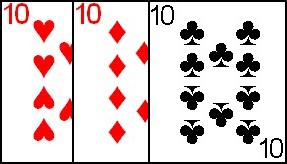 Three Card Set
Three Card Set |
|
|
- A run is a group of 3 or more cards, in sequence, of the same suit. For example, this could be 2, 3, 4 and 5 of Diamonds, or 10, Jack, and Queen of Spades.
Aces are equivalent to a value of one and thus can be played only in a run preceding a 2.
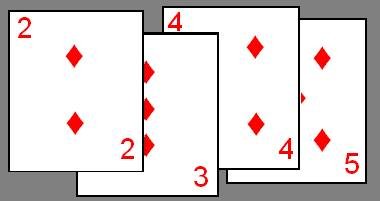 Four Card Run
Four Card Run
The dealer of the first hand can be determined in various ways, with cutting for high card
being a common method. Thereafter, the winner of each hand deals the next.
At the start of each hand, each player is dealt 10 cards face down in front of them.
The first card is given to the dealers opponent, the next to the dealer, the next to the opponent, and so on alternating until each player has 10 cards.
The next card in the deck is then turned face up on the table (this is called the upcard) and placed next to the remainder of the deck which is placed face down to form the stock.
After the cards are dealt and the players have examined their hands, the non-dealer has the first choice of taking the upcard.
If the non-dealer chooses not to take this card, the dealer then has the opportunity to take the card.
If both players decline the upcard, the non-dealer draws the top card of the stock and adds it to his hand, playing the hand as normal, including discarding at the end of his turn (see below).
Thereafter, each player on their proper turn, can opt to take the top upcard or the top card of the face down stock.
After selecting a card the player can then either knock or continue playing by discarding a card face-up to the top of the discard pile, which becomes the new upcard.
If a player takes the upcard, they may never discard that same card on that turn.
If the stock pile is reduced down to the last two cards, neither of these cards may be drawn. If the player who draws the third to last card of the stock does not knock at the end of his turn, the hand is over, being considered a draw with no scoring being considered for that hand.
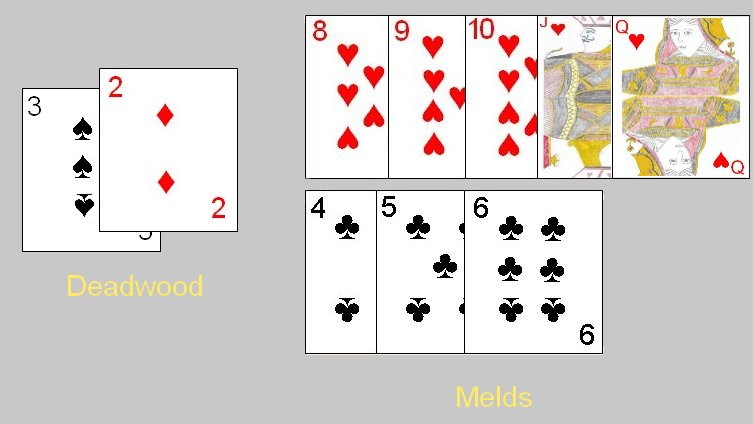
|
| In this example, a player has knocked with a total deadwood value of 5 in an effort to have a lower such count than his opponent.
|
Knocking: Any player on his normal turn of play may choose to
knock. To do so, a player would first draw a card as normal and then would indicate they are knocking.
A player can indicate a "knock" by actually making a knocking motion with the knuckles on the table or indicating this verbally by saying something such as "I knock". They would then discard one card from their hand face down. In order to knock a player must have a total value of unmatched cards in his hand of 10 or less after the discard.
As noted above for calculating this total, court cards are worth 10 points each, Aces one and all other cards their face value.
After knocking the player who does so lays his hand face up on the table, with all his melds grouped together and his unmatched deadwood separated.
Unless the knocking player has no unmatched cards, the opponent may lay off any unmatched cards in their own hand that might extend the runs and sequences of the knocking player. The knocking player, however, may not do so on his opponents melds.
If the total card value of unmatched cards of the knocking player is lower than the opponent, he wins the hand and scores for himself the difference between his hand and his opponents.
However, if the opponent has a lower or equal total card value, the opponent instead wins the hand and scores 25 points plus the difference in card counts. This is called an undercut.
In the event that the knocker has no unmatched cards after their discard, called
Going Gin, the opponent may not lay off any of their unmatched cards on the knockers melds (although they may set aside any of their own valid melds) and the knocker wins the hand regardless of the opponents total in unmatched cards. Going gin scores 25 points for the knocker plus his opponents total count in unmatched cards remaining in their hand.
Gin Rummy Scoring

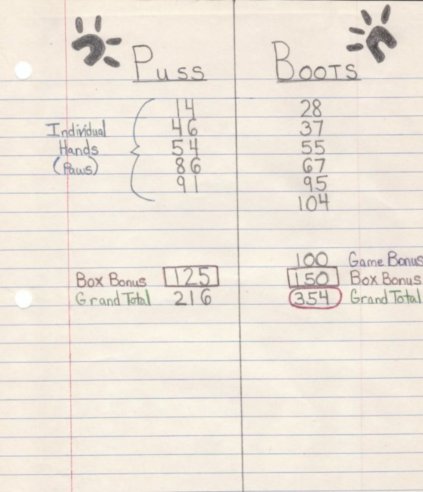 |
|
The first player to score 100 points wins the game. He also receives a 100 point game bonus added to his score. If the opponent has not won any hands during the game the winning player scores 200 instead. Each player then adds a 25 point additional bonus for each individual hand they have won through the course of the game. Each 25 points thus scored in this way is called a box or line bonus. The image to the left shows a possible sample score sheet for a game which consisted of 11 hands.
|
| |
|
|
|
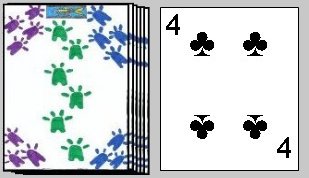 Oklahoma Gin:
Oklahoma Gin: This version is very similar to the standard version described above, however, the value of the turned upcard determines the lowest value for which a player may knock.
Thus, for instance, if the upcard were a four, a player could only knock if the total point count of unmatched cards (deadwood) in their hand was four or less. If the upcard is an Ace, a player can never knock and can only win the hand by going Gin. If the turned upcard is any spade, all player scores accrued from that hand are doubled.
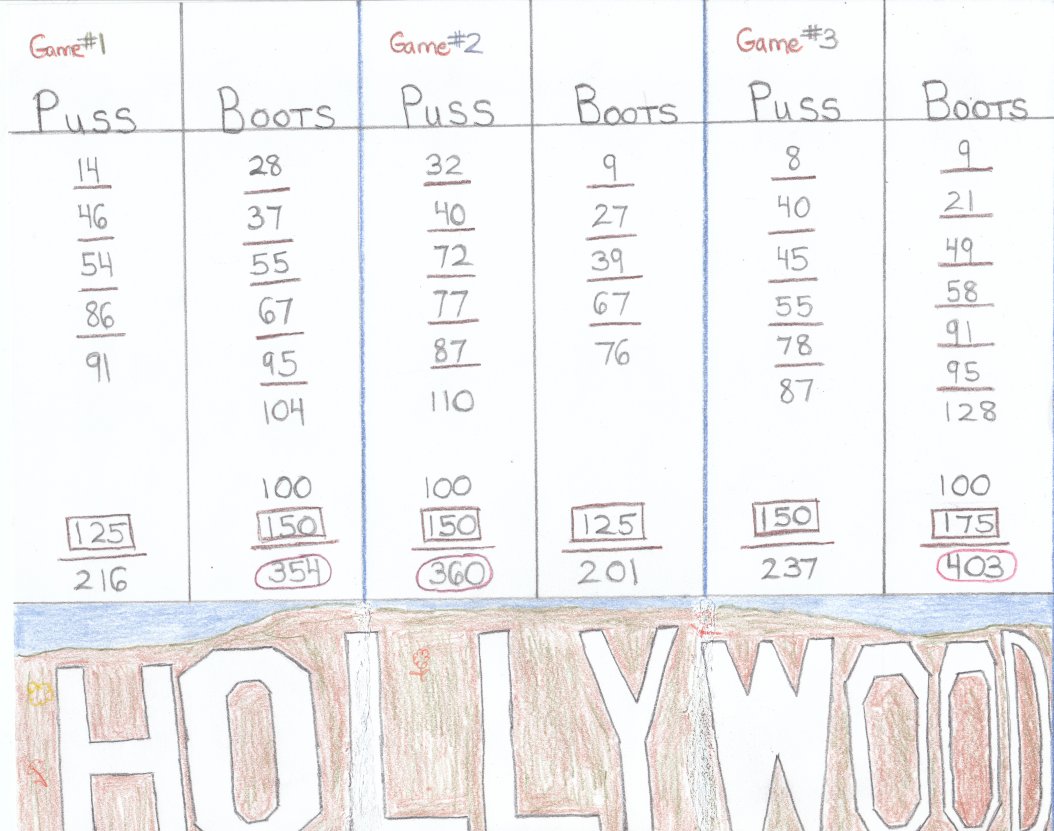 Hollywood Scoring:
Hollywood Scoring: Also called Hollywood Gin Rummy, this version is played exactly as the standard version as described above. How this game differs, however, is in the method of scoring. In Hollywood scoring, a player's score for a hand may be added in multiple "games".
For each player, three separate "games" are simultaneously being scored. When a player wins his first hand, he scores the points (as described in the standard game) in the first "game".
When he wins his second hand, the score is totaled in the first AND second game. For the third, and subsequent hands won, the total is added to all three "games". When 100 points is reached by any player in one of the "games" he wins that game. Once a "game" is won, additional scoring is not totaled for that game by any player,
but the remaining "games" should continue until those are also won by a player earning 100 points in those games as well. Each game is considered its own independent game, and any scoring bonuses for that game should be added as normal for that game. Generally, the overall winner is the player who wins two of the three "games".
Alternative Scoring: This version is identical to the standard version described above, however some of the scoring bonuses are different, as follows:
- Gin Bonus: 20 points
- Undercut: 10 points
- Box Bonus: 20 points
Gin Rummy for three players: Gin Rummy can also be played by three players, using differing variants:
- Two players actually play at a time, while the third player (who is the dealer) sits out the hand. Other than dealing, they take no other part in that particular hand.
The loser of that hand sits out the next hand taking the role of the dealer.
As in standard rummy, the first of the three players to score 100 (or higher) points is declared the winner.
For determination of the first player, have everyone draw a card from the deck and the player drawing the lowest card is the first dealer.
- Another version allows all three players to play in the same hand. In this variant, all draw one card to determine the first dealer.
High card drawn is the first dealer, and the player being dealt the next highest card is to his left. After the deal, the remainder of the deck is placed in the center of the table to form the stock. The top card of the stock is then turned over and placed beside the stock to start the discard pile. Each player then has the option to take this upturned discard, in specific order as follows; first the player to dealers left, then the player to that players left and finally the dealer.
If all players refuse the upcard, play begins with the player to dealers left who draws the top card of the stock to begin his turn. If any player takes the upcard, this starts his turn and he should discard as normal.
From this point forward, any of the players, in their proper turn, may take the last discard from either of his opponents (providing one hasn't been taken already by another player).
When one of the players knocks the other players may only lay off cards on the knocking players hand but not on any melds or extensions from the other (non knocking) opponent. Just as in two player Gin Rummy, if the knocking player goes "Gin", neither opponent may lay off any cards on the knocker's melds.
In this version, a score is kept for each separate player. At the conclusion of each hand, the winner scores the difference between his count (if any) and his two opponents counts totaled. The undercut bonus is not scored in this version. Instead, if the knocker is undercut 20 points are deducted from his current score. The knocker scores 40 points for going gin.
If the stock is reduced to the last three cards and no player has knocked the hand ends in a draw, with no scoring for that hand. Game is generally to 200 points, after which standard game bonuses are added for each player.
- Card Expert and game inventor John Scarne refined the three player variant rules further in a game called Jersey Gin. Jersey Gin is played similarly to the standard three player version described above in which all three players participate in the game. However, several changes were introduced which solidify the mechanics of the game. These include the following:
- The score a player receives after knocking is the total found by first subtracting the first opponents deadwood from his own and then subtracting the second opponents deadwood from his own and then adding this total. Each of these opponents neither earns or loses any score for the hand unless they manage to underknock the knocker (see below).
- If one of the opponents manages to underknock the knocker, the underknocker scores for the hand instead, using the following formula; The difference between his score and the knockers summed with the difference between his score and the other opponents plus a 10 point bonus for the underknock. If both opponents underknock the dealer, only one opponent can earn a score for the hand, this being the player with the lowest deadwood count of the two underknockers. In the rare event that both underknockers have the same total, the player to the knockers left scores for the hand (earning nothing from the other underknocker of course).
- If a player goes Gin he earns a score based on the total of both opponents deadwood plus a bonus of 40 points (20 point Gin bonus from each opponent).
The rules at the break are also somewhat different than in the two player game. A break occurs in Jersey Gin when the stock pile is reduced to exactly three cards. If this occurs before any players knocks or goes Gin, the player whose actual turn it is (called the breaker) may only pick up the top card of the discard pile if he may use it to create or add to a valid meld. Otherwise he must take the top of the stock pile. This applies for all plays after the break. After the stock is reduced to two cards or less, no player may knock (but can still go Gin, if able, with restrictions on the scoring, described below). After the break, each player, in their turn, must lay down all their valid melds on the table face-up in front of them (retaining their remaining unmeldabe cards in their hand). He then discards a card from his hand to the top of the discard pile as normal. The next player may lay off any cards on melds that have now been placed on the table. Play continues until the last card from the stock has been drawn, unless a player is able to go Gin. After that last player completes his turn, the scoring is calculated as listed above, with only the player with the lowest total in deadwood scoring for the hand. If two or more players tie for lowest score and one was the player to begin the break phase of the game, he is declared the winner of the hand. If two other players were tied, the one to the left of the breaking player is the winner of the hand, scoring accordingly. If a player manages to go Gin after the break, he scores, as normal, for all unmatched cards in the opponents hands but does not score any bonus points for Gin.
Four Player Gin Rummy: When four players play Gin Rummy they play in two partnerships of two players, each playing a separate game against one opponent from the other partnership. The partners sit opposite each other at the table with the dealer dealing to the opponent to his right.
The members of the partnership alternate opponents after each hand, but the members of the partnership remain the same for the entire game and each partnership keeps a single score for their side. After each hand, the partnership scores the difference in scores between the hand if any.
Thus, if one of the partners wins a hand by 28 points and the other loses by 18, the partnership earns 10 while the other partnerships scores nothing. The partnership which ends up getting the score for that particular hand, will also earn the 25 point box bonus. Usually game is scored to 125 points.
To determine partnerships, have all four players draw one card, with the two highest cards in partnership and the two lowest cards being the opposing partnership. For the first hand, the two opponents in that hand should cut for the first deal (high card cut deals first). For each subsequent hand, the winner from the last hand deals the next (which will be to the other opponents).
Eleven card hand: This version is played no differently than the standard game other than how the non-dealer begins his first turn. Instead of the usual 10 cards the non-dealer receives 11 cards. No upcard is turned from the deck. Instead, the non-dealer selects one of his cards and places it face up beside the draw pile to start the discard pile. The dealer then has his normal turn and the game proceeds as usual. This is often used in tournament play in an effort to offset any advantage or disadvantage the dealer or non-dealer may have in the game.
Around the Corner Gin Rummy:
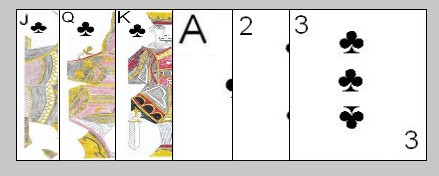 |
| Continuous
sequences are permitted in Around the Corner Gin |
This game is played identically to the parent game, with one major exception. The Ace can be used at either the top of a sequence (i.e. Jack, Queen, King, Ace) or the bottom of a sequence (Ace, 2, 3, 4). In fact, a run of cards containing the Ace can go "Round the Corner", such as the following "Queen, King, Ace, 2, 3".
When found as part of a players deadwood and for purposes of knocking, an Ace is considered to have a point value of 15 points. A score of 125 points is required to win the game.
Doubling: In this optional rule a player, at his proper turn of play may request a "double". If the opponent agrees to the double, all point scoring for the hand is doubled. This includes all bonuses and penalties scored for this particular hand. If the opponent opts not to agree to the double he must "resign". If the opponent does resign, the game is treated as if the player who doubled had knocked on this turn. However, the doubling player gets a bonus score of 20 points added to their final score of the hand. The resigning player cannot score for an undercut, even if he does manage to have a lower deadwood count than the doubling player. When the opponent does resign, the scores for the current hand are not doubled.
Redoubling: In many games where the doubling optional rule is played, redoubling is also allowed. If a player doubles, his opponent may then call "redouble". If the redouble is accepted by the original player, all scoring for the hand is doubled again, in affect with all scores being quadrupled for the hand. If a redouble is called, the original doubling player than has the option of resigning with the same results of this as when a double is called.
Gin Only: In this version no knocking is allowed. A player still retains all his melds in his hand, but may not go out until he has Gin (at which time he states "Gin"). As in the parent game of Gin Rummy, after stating "Gin", the player discards one card and then displays his hand in the matched sets. The scoring is as in normal Gin Rummy, with this player scoring 25 points for going Gin and also the total sum of points from unmatched cards found in his opponents hand. The opponent may never lay off cards on the knockers melds, but may arrange any legal melds he currently has in his hand. First to player to win 250 points at the end of a hand wins the game.
Colonel: The game Colonel is sometimes referred to as Coon-Can (Conquien) for two players, but, since the original game of Coon-Can already
is a two player game, and also since Colonel bears many resemblances to Gin Rummy, it appears this game is probably more closely related to Gin Rummy than Conquien (although most games of the Rummy family can ultimately be referenced back to Conquien.
Colonel is designed for two players using one standard 52 card deck. The ranking of the cards in this deck are as follows, from high to low: Ace, King, Queen, Jack, 10, 9, 8, 7, 6, 5, 4, 3, 2, Ace. It will be noticed that Aces are both high and low, however sequences of cards can never go around the corner. In other words, any run that contains an Ace must either have the Ace as the top highest card of the run (after a King), or as the lowest card in that run (before a two).
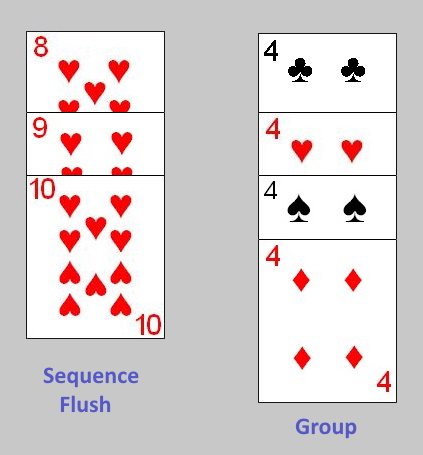 |
| Example of valid combinations in the card game Colonel |
Like most members of the Rummy family of card games, players attempt to form the hand into valid meld combinations which they play to the table as able during the turns. The valid melds which can be formed are Sequence Flushes and Groups. A Sequence Flush is three or more cards in direct sequential order, all of the same suit. A group is three or four cards all of the exact same
denomination.
Determination of seating positions and the first dealer can be performed using a variety of methods, with draw for low cards the most common such method. Each player draws a card from the shuffled pack, and the player drawing the lowest card (with
the Ace considered the lowest card in the deck for purposes of this draw) has first choice of seats and is set as the first dealer. Thereafter the role of dealer alternates amongst the two players.
Once the dealer has bee determined, this player then thoroughly shuffles the deck and offers it to his opponent to cut. After the cut, the dealer then begins dealing the cards, starting with his opponent and alternating amongst both players. He deals the cards one-at-a-time, and face down, until each player has a total of 10 cards, which forms that player's hand. After each player has his allotment of cards, the dealer places the remainder of the deck face-down in the center of the table as the stock pile. He then takes the top card from the stock pile and places it face-up next to the stock pile, to start the discard pile. This first, face-up card of the discard pile is called the option card.
After this, the players each pick up the hands and play begins, with the dealer's opponent having the first turn. Each turn in the game consists of the following actions:
- Each player starts his turn by drawing a card. The player may either draw the current top card from the face-up discard pile or the top face-down card from the stock pile.
- After drawing a card, a player may optionally declare any melds he might have. This consists of playing any legal melds (Sequence Flushes or Groups) onto the table in front of himself. The player may play any valid melds he has in his hand. In addition to new melds, if a player has one or more cards which may be used to extend existing melds already played on the table (either by himself or his opponent) he may also add those cards to the melds as found on the table. A player is never obligated to declare during his hand if he prefers not to.
- To complete his turn, each player then selects one card remaining in his hand and plays it to the top of the discard pile.
The game continues in this manner until either player, during his turn either manages to play the last of his cards in legal melds or he manages to play all but one card from his hand, then using that remaining card as his last discard. At that point the game immediately ends. All cards still remaining in his opponent's hand (whether they can be formed into valid meld declarations or not) are identified with a point value, with that total point value added to the score of the player who managed to deplete his hand. The value of the cards which might be found in a player's hand are as follows:
| Card | Point Value |
|---|
| Ace, King, Queen, Jack | 10 Each |
| 2, 3, 4, 5, 6, 7, 8, 9, 10 | Point value as marked on card |
If the last card of the stock pile is drawn, and the player drawing that card is unable to deplete his hand of cards, the game immediately ends. Each player then totals up the number of card points remaining in his hand (regardless of whether those cards could be used to form valid declarations). The player with the lower total earns a score based on his own score for that hand subtracted from the opponent's score for the hand.
At any time during the game either player may offer a Challenge. If the opposing player refuses the challenge the game proceeds as normal. However, if the opponent accepts the challenge, play immediately ends and both players total the number of card points remaining in his hand. Whichever player has the fewer number earns a point total for that hand equal to the total number of points found in his opponent's hand (in this case not required to subtract his own point total from that of his opponent on that hand). If both players have the exact same total of such unmatched cards, the hand ends in a tie with neither player earning any points for that hand.
After each hand, the players accumulate the points earned during the hand to an ongoing score for the player. After a set number of hands (one or more), the player with the higher grand total in points is declared the overall game winner.
|
|
|
Copyright © 2015 CatsAtCards.com. All rights reserved.
|




 Oklahoma Gin: This version is very similar to the standard version described above, however, the value of the turned upcard determines the lowest value for which a player may knock.
Thus, for instance, if the upcard were a four, a player could only knock if the total point count of unmatched cards (deadwood) in their hand was four or less. If the upcard is an Ace, a player can never knock and can only win the hand by going Gin. If the turned upcard is any spade, all player scores accrued from that hand are doubled.
Oklahoma Gin: This version is very similar to the standard version described above, however, the value of the turned upcard determines the lowest value for which a player may knock.
Thus, for instance, if the upcard were a four, a player could only knock if the total point count of unmatched cards (deadwood) in their hand was four or less. If the upcard is an Ace, a player can never knock and can only win the hand by going Gin. If the turned upcard is any spade, all player scores accrued from that hand are doubled.
 Hollywood Scoring: Also called Hollywood Gin Rummy, this version is played exactly as the standard version as described above. How this game differs, however, is in the method of scoring. In Hollywood scoring, a player's score for a hand may be added in multiple "games".
For each player, three separate "games" are simultaneously being scored. When a player wins his first hand, he scores the points (as described in the standard game) in the first "game".
When he wins his second hand, the score is totaled in the first AND second game. For the third, and subsequent hands won, the total is added to all three "games". When 100 points is reached by any player in one of the "games" he wins that game. Once a "game" is won, additional scoring is not totaled for that game by any player,
but the remaining "games" should continue until those are also won by a player earning 100 points in those games as well. Each game is considered its own independent game, and any scoring bonuses for that game should be added as normal for that game. Generally, the overall winner is the player who wins two of the three "games".
Hollywood Scoring: Also called Hollywood Gin Rummy, this version is played exactly as the standard version as described above. How this game differs, however, is in the method of scoring. In Hollywood scoring, a player's score for a hand may be added in multiple "games".
For each player, three separate "games" are simultaneously being scored. When a player wins his first hand, he scores the points (as described in the standard game) in the first "game".
When he wins his second hand, the score is totaled in the first AND second game. For the third, and subsequent hands won, the total is added to all three "games". When 100 points is reached by any player in one of the "games" he wins that game. Once a "game" is won, additional scoring is not totaled for that game by any player,
but the remaining "games" should continue until those are also won by a player earning 100 points in those games as well. Each game is considered its own independent game, and any scoring bonuses for that game should be added as normal for that game. Generally, the overall winner is the player who wins two of the three "games".

